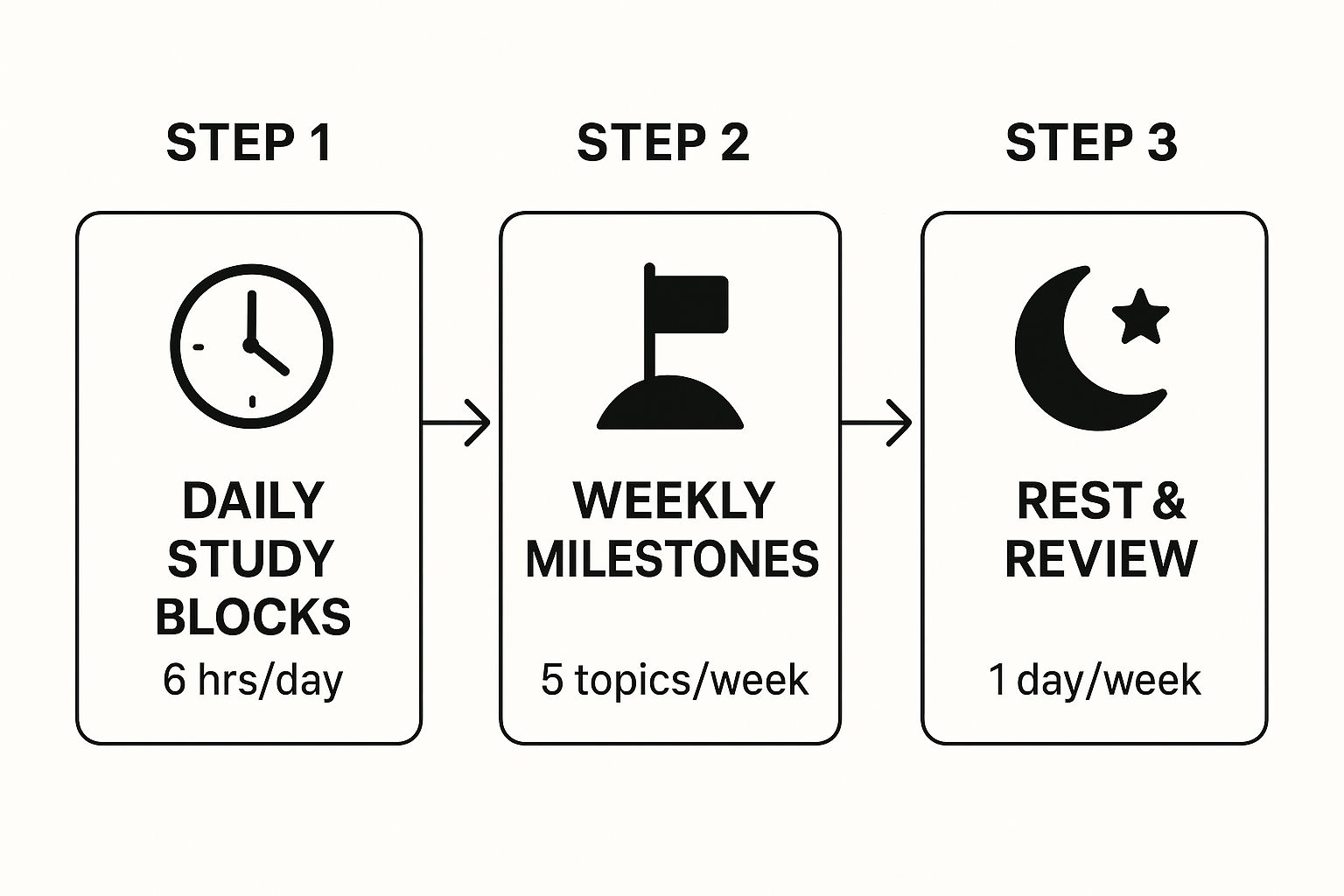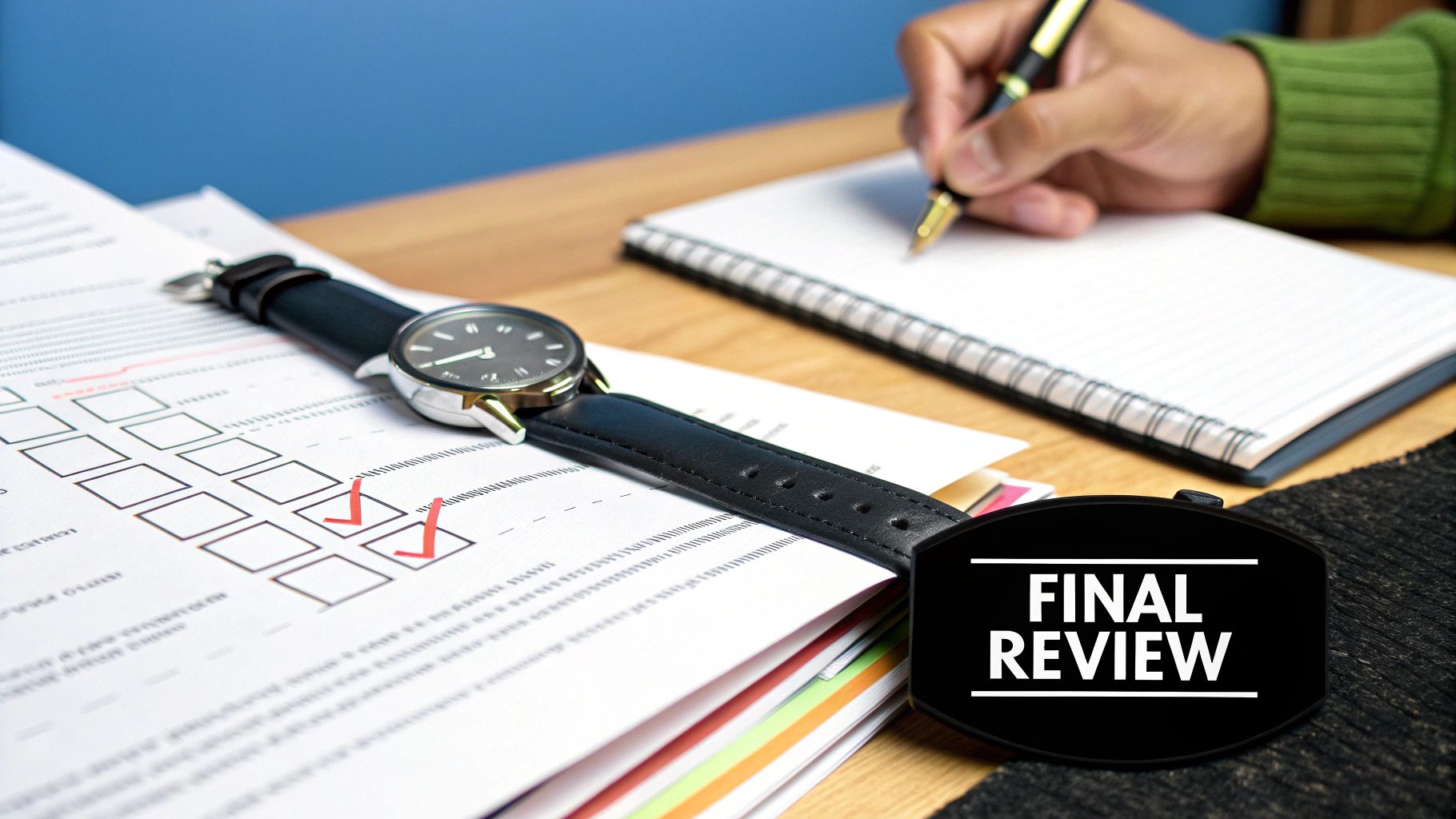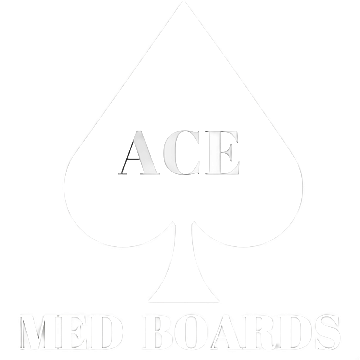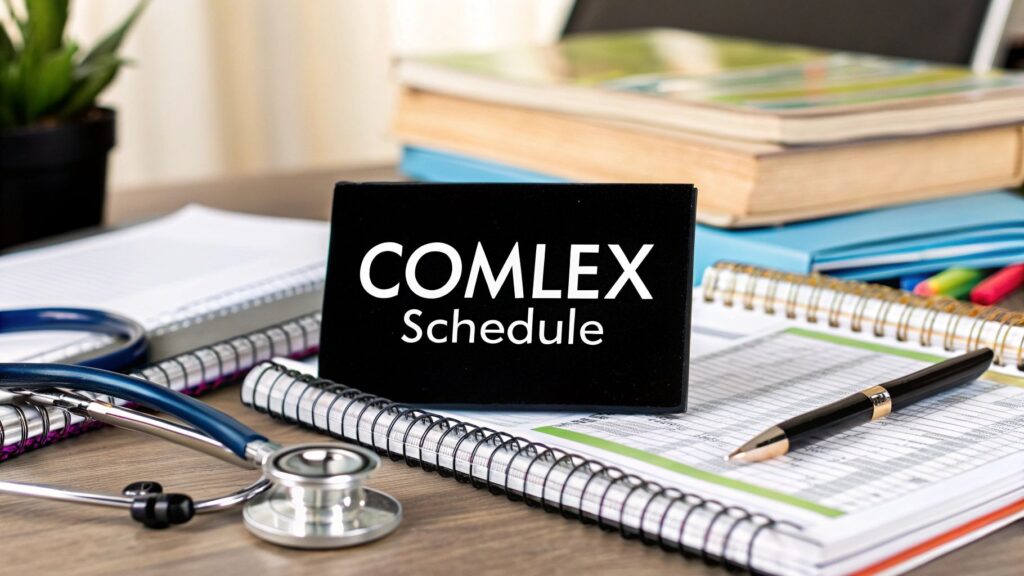So, you're staring down the barrel of the COMLEX Level 1. It's a beast of an exam, and mapping out your attack plan can feel just as daunting as the material itself. A solid study schedule isn't just a good idea; it's your lifeline for the next 3 to 6 months.
Most students find success by dedicating 20-30 hours of focused study each week. This isn't just about passively reading; it's a strategic mix of deep content review and grinding through thousands of practice questions to build both knowledge and test-taking endurance.
Building Your COMLEX Study Foundation
Before you even think about blocking out your daily study sessions, you have to lay the groundwork. This initial phase isn't about diving headfirst into microbiology or pharmacology. It's about smart, strategic planning. Think of your study schedule as a roadmap—and every good map starts with knowing exactly where you are right now.
The COMLEX Level 1 is a huge milestone for every osteopathic medical student. With pass rates for first-time takers historically hovering around 85-90%, you can't just wing it. A structured approach is non-negotiable. If you're curious about the numbers behind the prep, you can discover more insights about exam preparation statistics to grasp the commitment involved.
Perform a Brutally Honest Self-Assessment
First things first: take a baseline diagnostic exam. This isn't for a grade, and your ego needs to take a backseat. This is purely for data. The goal is to get a raw, unfiltered look at your strengths and, more importantly, your weaknesses.
Don't just glance at the overall score. Dig deep into the performance report. Where did you really struggle? Was it Anatomy? Biochemistry? Or did the Osteopathic Principles and Practice (OPP) questions throw you for a loop? Be specific.
A self-assessment isn't just about finding what you don't know; it's about quantifying the gap between your current knowledge and what's required to pass. This honest evaluation prevents you from wasting precious time on subjects you've already got a good handle on.
Once you have this data, you can start setting priorities. A subject where you scored in the 40th percentile needs a lot more love and attention than one where you're already hitting the 75th. This data-driven approach is what separates an efficient study plan from a frantic, disorganized one.
Select Your High-Yield Resources
With your weak spots clearly identified, it’s time to choose your weapons. It's incredibly easy to get overwhelmed by the sheer number of resources out there, from question banks like COMBANK and TrueLearn to the classic review books.
Your resource selection needs to be intentional. It should directly target the gaps you uncovered in your self-assessment.
Before you start buying every resource your classmates are talking about, take a moment to perform an initial self-assessment and choose your primary tools. This table provides a quick guide to get you started on the right foot.
| Initial Self-Assessment and Resource Selection |
| :— | :— | :— |
| Assessment Area | Action Steps | Recommended Resource Types |
| Overall Baseline | Take a full-length diagnostic exam (e.g., NBOME COMSAE) to get a starting score and performance breakdown by subject. | Diagnostic Exam (COMSAE) |
| OMM/OPP Weakness | Review your diagnostic report specifically for Osteopathic Principles and Practice. How did you do on these unique questions? | Dedicated OMM/OPP QBank, video series (e.g., OnlineMedEd), or a focused review book like Savarese. |
| Systems-Based Gaps | Identify the top 2-3 systems (e.g., Cardiology, Renal, Neuro) where you scored the lowest. This is where you'll focus your initial content review. | Comprehensive QBank (COMBANK, UWorld), Content Review Source (First Aid), Video Lectures (Boards and Beyond, Pathoma) |
| Test-Taking Stamina | Honestly assess how you felt at the end of the diagnostic. Fatigued? Rushed? This helps determine how much to prioritize timed practice blocks. | Primary QBank with timed and tutor modes. |
By using this structured approach, you ensure your resource choices are directly tied to your needs, setting a strong foundation for your study plan.
Here's how to build your core toolkit:
- Primary Question Bank: Pick one main QBank and stick with it. Whether it's COMBANK or UWorld, this will be your central hub for practice and learning to recognize patterns in how questions are asked.
- OMM-Specific Resource: The COMLEX is heavy on Osteopathic Manipulative Medicine. You absolutely need a resource dedicated to it. This could be a specialized QBank, a video series, or a classic review book like Savarese. Don't neglect this.
- Content Review: Choose a primary source for content review, like First Aid for the USMLE Step 1 (it's still incredibly high-yield for COMLEX). But be ready to pull in other materials, like video lectures or different texts, for your weakest subjects.
Whatever you do, avoid the trap of resource overload. Spreading yourself thin across five different platforms is a recipe for disaster. It's far more effective to master two or three high-quality tools than to dabble in a dozen. This foundational planning sets the stage for a focused, productive study period and helps you avoid the early burnout that sidelines so many students.
Designing Your Phased Study Timeline
Alright, you've got your resources picked out. Now comes the real challenge: turning that pile of books and QBank subscriptions into a concrete, manageable study timeline.
A winning COMLEX Level 1 schedule isn't just a giant, six-month block on your calendar labeled "Study." That’s a recipe for burnout. Instead, think of it as a dynamic plan broken into distinct phases. This approach lets you build a solid knowledge base first, then gradually ramp up the intensity as you get closer to exam day. It’s the key to retaining information without hitting a wall.
This isn't just a hunch; it's a strategy backed by how high-performers prepare. Data from similar high-stakes exams show that a structured, phased approach makes a real difference. In fact, one study found that 70% of examinees who divided their prep into content review, question practice, and full simulations felt more confident and scored better. You can dig into similar research on exam readiness and phased prep here.
At a high level, your weekly rhythm should look something like this simple but powerful framework.

This visual really drives home the cycle: consistent daily work, clear weekly targets, and—most importantly—dedicated time to review and recharge.
Phase 1: The Content Mastery Phase
This is where it all begins. Think of this as your foundational period, usually lasting the first several weeks or even a couple of months, depending on how early you start. The goal here is brutally simple: build and reinforce your core knowledge.
Your schedule in this phase should be all about system-based learning. You might dedicate an entire week to cardiology, then move on to pulmonology, then GI. Go deep before you go wide.
Here’s what a typical week might look like:
- Monday-Friday: Zero in on one organ system. Each day, you'll tackle the relevant videos (from sources like Pathoma or Boards and Beyond), read the matching chapter in First Aid, and then do a small block of 20-40 QBank questions on that specific topic. Use tutor mode here—the goal is learning, not speed.
- Saturday: This is your dedicated review day. It’s absolutely crucial. Go back over everything from the past week. Consolidate your notes, drill your flashcards, and, most importantly, meticulously review every single question you got wrong.
- Sunday: Rest. Seriously. This is non-negotiable. Your brain needs time off to consolidate memories and prevent burnout. Don't skip it.
A critical piece of advice: Don't treat Osteopathic Manipulative Medicine (OMM) as an afterthought. Weave it in from the very beginning. When you're studying musculoskeletal, review the OMM techniques for the spine and ribs. When you cover neurology, review cranial techniques. Integrating it makes it stick.
Phase 2: The Integrated Practice Phase
So, you've got a solid handle on the individual subjects. Fantastic. Now it's time to start throwing them all in a blender. The real COMLEX doesn't serve you up neat little blocks of cardiology questions. It’s a chaotic mix, and you need to train your brain to pivot from one topic to the next without missing a beat.
This phase usually kicks in about 6-8 weeks before your dedicated study period.
The big shift here is moving from subject-specific QBanks to mixed, random sets. Your daily question blocks should now be timed. You’re not just testing knowledge anymore; you’re building test-taking endurance and speed. Keep reviewing your incorrects, but now you'll start seeing patterns across different systems, which is invaluable for targeting your weak spots.
Phase 3: The Dedicated Prep Phase
Welcome to the final boss battle. This is that intense, all-in push, typically the 4-6 weeks right before your exam. Your schedule gets way more intense, designed to mimic the real test day as closely as possible.
During this final stretch, you’ll be taking full-length practice exams (like NBOME's COMSAEs) every single week. This is essential for building stamina and learning how to manage your time and energy under pressure.
Your days will be a mix of big, timed question blocks (80-120 questions) and highly focused review of your weakest areas and high-yield topics.
And a final pro-tip: schedule your last full-length practice test about 5-7 days before your actual exam. This gives you enough time for some final, light review and, most importantly, to rest and walk into the testing center feeling fresh, not fried.
Mastering Content with Active Learning

Okay, you've got a killer timeline. But a schedule is just a container—what you do inside those study blocks is what actually gets you a passing score.
If your strategy is to just re-read First Aid or binge-watch lectures, you're setting yourself up for a world of pain. That's passive learning. It creates an illusion of knowing the material, but when you're faced with a tough COMLEX question, that knowledge vanishes. It was never really yours to begin with.
The secret is to switch to active learning. This is where you force your brain to get its hands dirty, to struggle with the information, and to forge real connections. Instead of just highlighting a paragraph on renal physiology, you need to actively wrestle with the concepts.
Embrace Spaced Repetition and Recall
One of the most powerful tools in your arsenal is spaced repetition. It's the simple idea that reviewing information at increasing intervals—just as you're about to forget it—burns it into your long-term memory. This is non-negotiable for an exam that covers an ocean of material.
Systems like Anki are built for this. Instead of cramming a topic once and hoping for the best, you’ll review a concept a day later, then in three days, then a week, and so on. This process is how you move information from fragile, short-term memory to the durable, long-term storage needed for exam day.
For a deeper look, check out our guide on active recall for medical students. It's packed with strategies you can start using right now.
The core idea is this: The harder your brain works to pull out a piece of information, the stronger that memory becomes. Passive reading feels easy because it is easy—and ineffective. Active recall feels hard because it actually works.
Apply the Feynman Technique for Tough Topics
When you inevitably run into a nightmare topic—think brachial plexus or the coagulation cascade—the Feynman Technique will be your best friend. It’s brilliant because it's so simple.
Here’s how to put it into action:
- Grab a blank piece of paper and write the concept at the top (e.g., "Glycolysis Pathway").
- Explain it out loud, in your own words, as if you were teaching it to a first-year undergrad. Keep it simple. Use analogies.
- The moment you get stuck, use jargon you can't define, or have to peek at your notes—that’s your knowledge gap. Circle it.
- Go back to your textbook or video, but only to understand that one specific point. Then, go back to your sheet and refine your explanation until you can teach the whole thing, start to finish, without getting stuck.
This method doesn't just show you what you know; it mercilessly exposes what you don't. It turns you from a passive sponge into an active teacher of the material.
Build Connections with Concept Maps
Finally, you need to break free from linear, list-based notes. Medicine is an interconnected web of systems, and that’s how COMLEX tests it. Concept maps are perfect for this.
Don't just study heart failure and kidney failure as two separate chapters. Create a visual map.
Put "Heart Failure" in a bubble in the center. Then, draw branches to its effects: decreased cardiac output, RAAS activation, increased sympathetic tone. From those branches, draw more lines showing how each one hammers the kidneys. This visual approach helps you see the story—how one system's dysfunction cascades into another's. It's this integrated understanding that separates a passing score from a failing one.
Using Question Banks and Practice Exams
A rock-solid timeline and active learning are the engine of your study plan, but practice questions are the fuel. QBanks are absolutely essential, but mindlessly clicking through thousands of questions isn't a strategy—it's just busywork. The real magic is in how you use them to diagnose weaknesses, build stamina, and master the exam’s unique logic.
Think of your QBank as more than a quiz tool. It's your personal data source for fine-tuning your COMLEX Level 1 study schedule. In the beginning, you’ll probably use it in tutor mode to learn the material cold. But as you get closer to exam day, you have to shift your focus. Start doing timed, mixed blocks that mimic the pressure and randomness of the real thing. This forces you to switch mental gears on a dime, jumping from microbiology to OMM, which is a make-or-break skill on test day.
Go Beyond Broad Subject Analysis
It’s tempting to look at a score report and just say, “Well, I’m bad at cardiology.” That’s not specific enough to actually do anything about. A truly powerful analysis digs way deeper.
Instead of focusing on a huge topic, you need to pinpoint the exact concept tripping you up. For instance, is that low cardiology score because you don’t get murmurs, struggle with cardiac pharmacology, or can’t make sense of EKGs?
Your QBank’s analytics will tell you this. Hunt for patterns in your incorrect answers. You might realize you’re not bad at "pharmacology" as a whole, but you consistently mess up questions about autonomic drugs. Suddenly, a vague weakness becomes a concrete, fixable problem.
Strategically Schedule Full-Length Practice Exams
Practice exams are milestones, not just another study task. They have two critical jobs: measuring your progress and building the mental endurance you need for an 8-hour test day. It's totally normal to stumble out of the testing center feeling like you’ve run a marathon, and these practice runs are how you train for it.
Integrating full-length exams into your dedicated period is key for assessing progress and building the necessary stamina. Below is a sample timeline that shows you how to space them out effectively.
Practice Exam Schedule and Review Strategy
| Weeks Before Exam | Recommended Assessment | Primary Goal |
|---|---|---|
| 6 Weeks Out | NBOME COMSAE or other full-length exam | Establish a solid baseline score for your dedicated prep period. |
| 4 Weeks Out | Another full-length practice exam | Identify remaining high-yield weak areas to focus on in the final month. |
| 2 Weeks Out | Final full-length exam | Simulate test day conditions precisely. Fine-tune timing and break strategy. |
| Final Week | Light review & short question blocks only | Rest and consolidate knowledge. Do not take a full-length exam this week. |
Properly reviewing these exams is just as important as taking them. You need to block out at least 4-6 hours the day after to go through every single question—the ones you got right and the ones you got wrong. This process alone is one of the highest-yield activities you can do. Our guide on effective medical exam study tips has more on turning this review into real score gains.
The goal of reviewing an exam isn't just to see the right answer. It's to understand why you got a question wrong, why the correct answer is right, and, just as importantly, why the other distractors were wrong. This turns every mistake into a learning opportunity.
Of course, the sheer volume of questions you do matters, too. The data is clear: there's a strong link between question volume and success. Students who complete over 10,000 practice questions during their prep have a pass rate up to 15% higher than those who do fewer than 3,000. You can see similar trends across other high-stakes tests by exploring the impact of practice volume on exam pass rates. This just hammers home the point that consistent, high-volume practice is a cornerstone of a winning COMLEX Level 1 study schedule.
Adjusting Your Schedule and Avoiding Burnout
Let's be realistic: no matter how perfectly you map out your COMLEX Level 1 study schedule, life is going to throw you a curveball. You’ll have days where you feel completely off, fall behind, or start questioning the entire process. This isn't a sign of failure. It’s an expected, normal part of the marathon.
The real skill isn't creating the perfect plan—it's knowing how to adapt without panicking.
The immense pressure of board prep creates a perfect storm for mental and physical exhaustion. It's crucial to spot the early warning signs before they completely derail your progress. Are you feeling constantly on edge? Is your focus shot, making it a struggle to even get through a single question block?
These aren't just "bad days." They are signals from your body screaming for a recalibration. For a deeper look at this, our guide on managing USMLE and COMLEX exam burnout has some targeted advice that can really help.
Recalibrating When You Fall Behind
When you get off track, the absolute worst thing you can do is try to cram two days of studying into one. That approach is a fast track to even greater exhaustion and, frankly, it just doesn't work.
Instead, take a breath and reassess.
Look at your schedule and pinpoint the lowest-priority tasks from the day you missed. Can you push that review topic to your next flex day? Maybe you can shorten your QBank blocks by just a few questions for a couple of days to catch up on more vital content. The goal here is to make small, sustainable tweaks, not to punish yourself with an even more brutal schedule.
Your study plan is a living document, not some rigid contract you signed in blood. Being able to flexibly adjust your COMLEX Level 1 study schedule is just as important as the initial planning. Give yourself permission to be human.
Building in a Weekly "Flex Day"
One of the most powerful strategies you can use is to build a safety valve directly into your weekly schedule. Designate one day—or even just an afternoon, like a Saturday or Sunday—as your "flex" time.
This day has a brilliant dual purpose:
- Catch-Up Mode: If you fell behind during the week, this is your dedicated, no-stress time to cover that missed material without messing up the week ahead.
- Rest and Recharge: If you’re already on track? This time becomes a mandatory break. Go for a hike, see friends you haven't seen in ages, or do absolutely nothing related to medicine. Protecting this time is essential for your long-term endurance.
Sleep, Nutrition, and Exercise Are Non-Negotiable
When you're deep in the study grind, it's incredibly easy to let self-care slide. You start trading an hour of sleep for a few more flashcards or grabbing fast food just to save time. This is a massive mistake.
Sleep is literally when your brain consolidates memory. Skimping on it directly undermines all the hard work you’re putting in.
Similarly, nutrient-dense food and regular physical activity are proven to boost cognitive function and slash stress. These aren't luxuries; they are fundamental components of peak academic performance. For more on this, check out these proven strategies for preventing burnout in healthcare, which offer some great resilience tips.
Treating self-care as a priority will pay huge dividends on exam day.
Common Questions About Your COMLEX Schedule

Even after you've mapped out the perfect framework, the little details can trip you up. It's totally normal for specific questions to surface as you start building your day-to-day COMLEX Level 1 schedule.
Let’s get into some of the most common ones I hear from students. Getting these answers straight will give you the clarity and confidence you need to really own your prep plan.
How Far in Advance Should I Start Studying?
This is probably the number one question I get, and the honest answer is, it really depends. That said, starting earlier is almost always the safer bet. Most osteopathic students jump into their dedicated study period about 4 to 6 months before their test date, which is usually a solid window to cover everything without feeling totally crushed.
Here’s a pro tip: take a diagnostic exam, like a COMSAE, about 6 to 8 months out. It’s the best way to get a real, unfiltered look at your baseline score and, more importantly, pinpoint your weak spots. If you find your basic sciences are rustier than you thought, you can start some light content review even earlier to shore up that foundation before the real grind begins.
Should I Use USMLE Resources Like UWorld?
Yes, absolutely—as long as you’re smart about it. Resources like UWorld are fantastic for cementing the core biomedical science concepts that are a huge part of the COMLEX. Their explanations are second to none for building a deep understanding of pathophysiology and pharmacology.
But you can't stop there.
It's absolutely critical to pair any USMLE resource with a COMLEX-specific QBank like COMBANK or TrueLearn. This is the only way you'll get enough practice with Osteopathic Manipulative Medicine (OMM) questions and truly get a feel for the unique, often more clinical-vignette style of the COMLEX.
A powerful combination many successful students use looks something like this:
- UWorld: Use it to build that rock-solid foundation in all the basic science systems.
- COMBANK/TrueLearn: Switch to this for dedicated OMM review and full-length simulations to get your timing and test-taking strategy down for the real deal.
How Many Practice Questions Should I Do?
While the quality of your review will always be more important than just the number, volume still matters. A lot. It's how you build the pattern recognition needed to crush this exam. You should plan on finishing at least one full pass of a major QBank, which is usually over 3,500 questions.
But don't just stop after one pass. A second run-through focusing only on your incorrect and marked questions is essential for turning weaknesses into strengths. Many of the highest-scoring students I've worked with manage to get through a huge chunk of a second, COMLEX-specific QBank as well. A great target to aim for is somewhere between 4,000 and 7,000 unique practice questions over your entire study period.
What Should My Final Week Look Like?
The last week before the exam is all about tapering, not cramming. The goal is to walk into that test center feeling sharp, rested, and confident—not frazzled from a week of panicked, all-night study sessions.
Your schedule needs to change dramatically. Slash your study hours in half. Focus on light, passive review of your high-yield notes, some quick OMM refreshers, and maybe a few short, untimed question blocks just to stay in the rhythm.
Most importantly, do not take a full-length practice exam in the last 4 to 5 days. The risk of a bad score wrecking your confidence far outweighs any potential benefit. The day before your exam? Do absolutely nothing. Relax, eat a good meal, and get a full night's sleep. Trust the work you've put in.
Feeling overwhelmed by the sheer volume of material? The expert tutors at Ace Med Boards can help you design a personalized COMLEX Level 1 study schedule, identify your specific weaknesses, and master high-yield topics. Get the one-on-one guidance you need by booking a free consultation at https://acemedboards.com.

